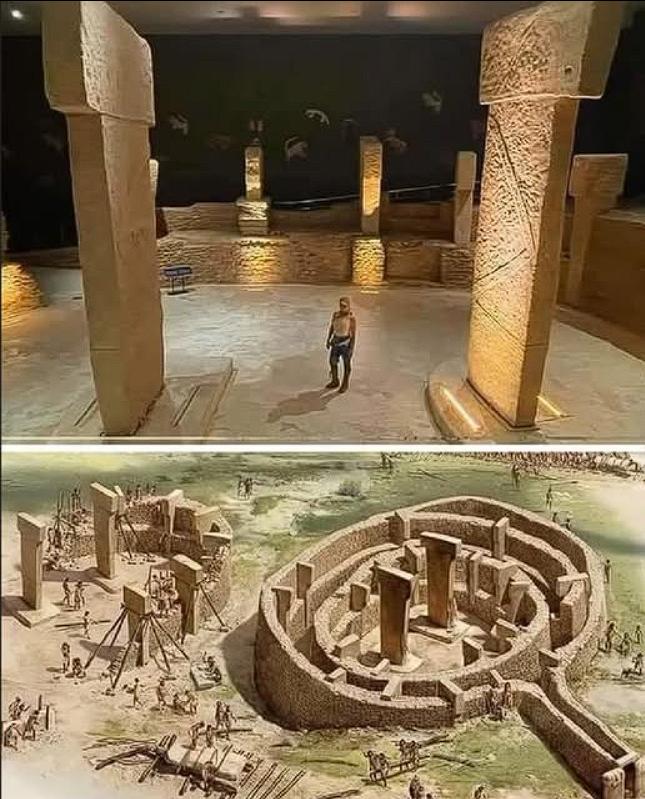Göbekli Tepe: The 11,000-Year-Old Temple That Changed Everything We Knew About Civilization
High above the rolling plains of southeastern Turkey, near the modern-day city of Şanlıurfa and not far from the Syrian border, lies one of the most enigmatic archaeological discoveries of our time—Göbekli Tepe. At first glance, it appears to be a series of massive stone circles, some with central pillars towering nearly 7 meters high. But once the layers of dust and time are pulled back, these stones whisper a story that is rewriting everything we thought we knew about the dawn of civilization.
Radiocarbon dating reveals a staggering truth: Göbekli Tepe was built more than 11,000 years ago, long before the rise of agriculture, cities, or writing—long before the pyramids of Egypt or the ziggurats of Mesopotamia. In fact, it predates Stonehenge by at least 6,000 years.
And yet, the people who built it remain anonymous, their identity lost to time. No written language, no domesticated animals, no pottery. Just stone, vision, and an unwavering will to create something eternal.
A Temple Before Cities: The Puzzle of Göbekli Tepe
Ancient Stones with Modern Implications
When German archaeologist Klaus Schmidt first began excavations at Göbekli Tepe in the 1990s, what he unearthed stunned the world. Giant T-shaped limestone pillars, carved with reliefs of animals—lions, snakes, wild boars, vultures, and scorpions—formed concentric stone circles. Some pillars weighed up to 10 tons, and had to be moved without the aid of wheels or beasts of burden.
More astonishing than their scale was their sophistication. These weren’t just crude monuments. The carvings were elegant, symbolic, and suggestive of ritual or spiritual meaning. Unlike other prehistoric sites, Göbekli Tepe wasn’t a settlement. There were no traces of permanent habitation—no homes, no agriculture, no burials.
It was a ceremonial site, possibly a temple. And it was built by people who were still thought to be nomadic hunter-gatherers.
Flipping the Timeline of Civilization
Until Göbekli Tepe, the mainstream archaeological consensus held that agriculture came first, followed by permanent settlements, and only then came religion and monumental architecture. But Göbekli Tepe reversed that order.
Here was a site that seemed to suggest the opposite: that spiritual or communal rituals may have sparked agriculture, not the other way around. Perhaps the need to gather together for religious observances encouraged early humans to cultivate crops, domesticate animals, and build lasting communities.
In the words of Schmidt, “First came the temple, then the city.”
How Was Göbekli Tepe Built?
Prehistoric Ingenuity Without Metal or the Wheel
One of the most enduring mysteries of Göbekli Tepe is how it was built. The site dates back to the Pre-Pottery Neolithic period (circa 9600 BCE). At this time, tools were made of flint and obsidian. The builders had no metal, no carts, and no draft animals.
Yet they quarried limestone from nearby outcrops, carved immense pillars, and transported them across uneven terrain to erect them upright in complex geometrical arrangements.
This required not just engineering skill, but also social organization. People had to coordinate labor, design structural plans, and invest years—perhaps generations—into the project.
Sacred Geometry and Symbolism
The layout of Göbekli Tepe reflects an understanding of cosmic and symbolic order. The T-shaped pillars are believed to represent stylized human forms, with arms and hands carved into their sides. Some archaeologists interpret the central pair in each circle as deities or ancestors, watching over the ceremonies.
Whether the site was aligned with stars, solstices, or other celestial phenomena remains a topic of debate. But many scholars suspect astronomical significance.
Why Was Göbekli Tepe Buried?
A Deliberate Burial
One of the strangest facts about Göbekli Tepe is that it was intentionally buried. Sometime around 8,000 BCE, the people who built it covered the entire complex with tons of earth, effectively preserving it for millennia.
Was it a ritual closure? A cultural shift? A practical decision?
We may never know for sure. But the deliberate nature of the burial preserved the stone carvings in extraordinary condition—so well, in fact, that some of the animal motifs still appear almost fresh from the chisel.
Abandonment and the Rise of Agriculture
Interestingly, the time of Göbekli Tepe’s burial roughly coincides with the rise of settled farming communities in the region. Sites like Nevalı Çori and Çayönü—located not far from Göbekli Tepe—began showing signs of crop cultivation and animal domestication.
Could it be that once agriculture took root, the rituals and worldview that required Göbekli Tepe faded into irrelevance? Or were the builders part of a transitional generation, straddling the line between nomadic and settled life?
What We Still Don’t Know
Who Built Göbekli Tepe?
To this day, the identity of the builders remains one of archaeology’s greatest unsolved riddles. They left no written language, no names, no legends passed down. We know only that they had the will and wisdom to shape stone into meaning.
Was Göbekli Tepe a One-of-a-Kind Site?
For years, Göbekli Tepe seemed like an anomaly. But new excavations in Karahan Tepe, Sefer Tepe, and other sites in the same region suggest a network of similar ceremonial centers, indicating a broader spiritual culture in prehistoric Anatolia.
Göbekli Tepe may have been the hub of a much older and more complex civilization than we ever imagined.
What Was Its True Purpose?
Was it a temple? A sanctuary? A seasonal gathering place for scattered tribes?
Some scholars argue that the carvings represent a creation myth or an early cosmology. Others see it as a place of initiation, where knowledge or spiritual insight was passed from generation to generation.
One thing is certain: Göbekli Tepe wasn’t built for survival. It was built for meaning.
A Testament to Our Forgotten Genius
In a world where skyscrapers rise and fall in decades, Göbekli Tepe stands as a reminder of human depth and ingenuity, born not from abundance, but from need—from the desire to understand our place in the cosmos.
It challenges the notion that early humans were simple, brutish beings. Instead, it paints a portrait of a people driven by myth, mystery, and the sacred, capable of organizing vast projects with no promise of survival reward—only belief.
And perhaps, buried beneath the ground for millennia, Göbekli Tepe was always meant to reemerge at the right moment in history—to remind us of where we came from, and how little we truly know about the origins of civilization.

CÁC TIN KHÁC
Mary Walton: The Forgotten Inventor Who Helped Clean Up America’s Cities
Tomb of Queen Nefertari in the Valley of the Queens, Egypt
Discover the Hypostyle Hall of the Temple of Hathor at Dendera
Venus de Losange: Unveiling the Mystery of a 20,000-Year-Old Paleolithic Icon